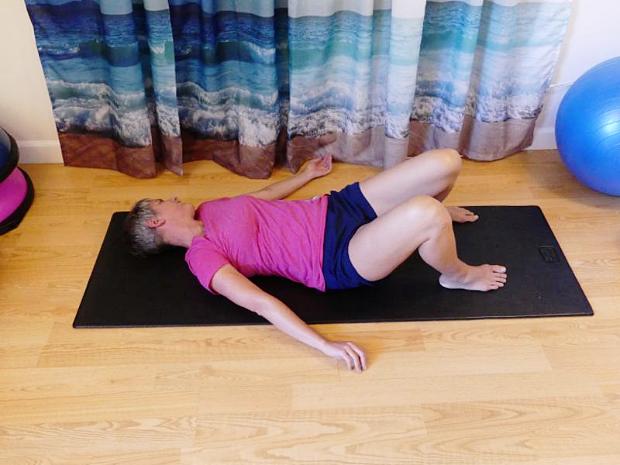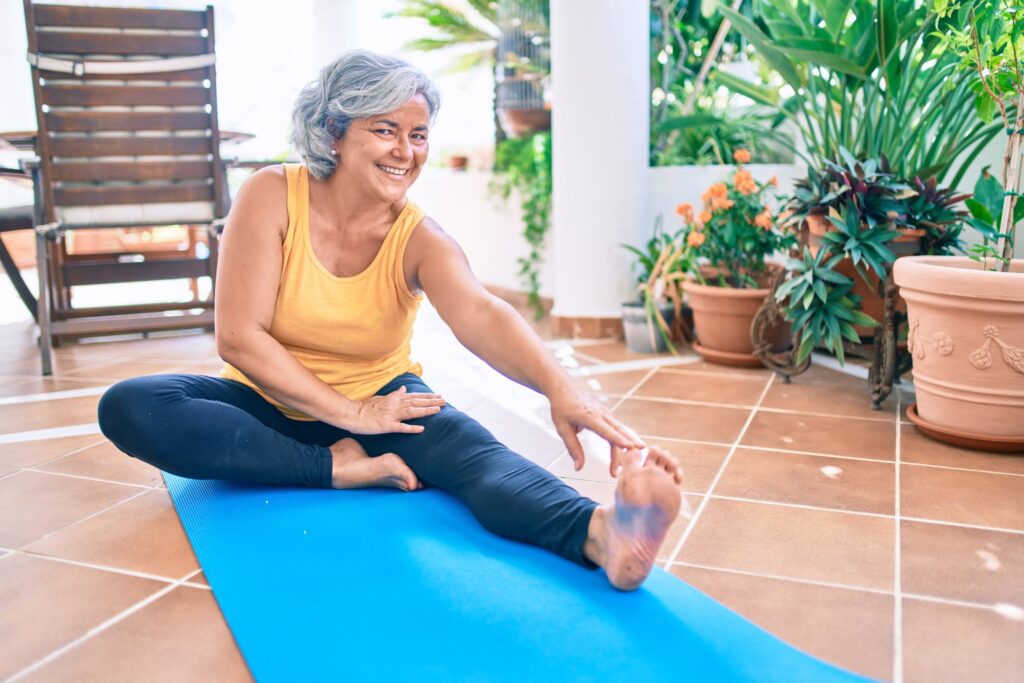Fluid’s signature R.O.S.S.™ method encourages mindful movement and injury prevention.
Click here to watch Anne and Heather discuss healthy movement and R.O.S.S.!
- Releasing tight muscles warms soft tissue and facilitates your brain/body connection.
- Organizing your small stabilizers for support and efficient movement patterns.
- Strengthening large muscle groups builds muscle and bone strength and power.
- Stretching at the end of your session (not at the beginning) improves range of motion, reduces muscle soreness, calms your nervous system, and facilitates smooth, graceful, supple movement.
Release:
Release work is using your mind to consciously soften a tight muscle, improves your mind/ body connection, facilitates relaxation, and trains your body to work more efficiently.
Often when we’re injured or suffering from muscle tightness, we think, “Oh, I should stretch.” Yes, that’s true, you should stretch…after you’ve done release work, stabilization exercises, and strength work.
If a muscle is chronically contracted, and you ask it to shorten (lifting weights, biking) you may struggle to efficiently build strength, or take your joint through a full range of motion. If you try to lengthen it via passive, long held stretches (when your muscles are cold) your brain may sense danger, tightening up even more in an effort to protect you from injury.
In the photo below, I’m demonstrating “washrag” a somatics exercise where you slowly and gently twist your torso, creating tightness on the diagonal, then slowly allow your muscles to soften. This is an example of release work.

Organize:
Our next step is organization, or stabilization. Now we ask the small muscles to get on board. These muscles maximize efficiency by kicking in a millisecond before your larger prime movers. For example, as you reach down to lift a heavy box, your pelvic floor and deep abdominals engage, then your legs, back, shoulders, and arms activate to lift the box.
If you tend towards hypermobility, training for stability is especially important for you. Learning how to stack your ribs over your hips and keep your hips level while doing a single leg squat or lunge will help you build muscle safely and efficiently. Training your joints for stability so that your big movers (in this case glutes, quads and hamstrings) can literally to the heavy lifting.
Bird dog below is a good example of organization. I’m lifting my right arm and left leg while keeping my torso still. This is a “core” exercise (no sit ups required).

Strengthen:
We released, we organized, now it’s time to strengthen. The American College of Sports Medicine strength guidelines call for 2-3 days a week of resistance training, including exercises that strengthen all major muscle groups.
Shoot for 2-3 sets, 8-15 reps of each exercise.
If you are not sure how to program your strength session, think of this general format:
- hinge
- push
- pull
- hang
- twist
This could look like a quick warm up (brisk walking or stair climbing) followed by squats or dead lifts, pushups (or plank hold), rows, pull ups (or hanging) and a seated twist holding a medicine ball or dumbbell.

As you’re lifting weights can you breathe, maintain proper form, and perform your movements in a controlled manner and through a full range of motion? If not, stop and reorganize yourself.
Stretch:
Lastly, we stretch. The manner of stretching I do with my clients (and myself) has changed quite a bit over the years. Along with static stretches, I incorporate gentle movement and a sense of ease while stretching.
For example, focusing on breathing and relaxing your leg muscles during a passive hamstring stretch (maybe even smiling like this sweet lady).

When we force ourselves into an overstretched position, our brain sends a message to our muscles that we’re in danger of injury and our muscles contract to protect the joint and soft tissue. If we breathe into a stretch, moving with curiosity rather than force, our muscles naturally lengthen and relax.
Using R.O.S.S.:
So how do we incorporate this concept into our workouts? In a sixty minute class, we may start with five minutes of release work, another five to ten minutes of organization, the next forty minutes or so of strength work, then spend the last five minutes stretching.
When training a client who is recovering from an injury, I may flip that equation, doing primarily release and organization work, and less strength work, depending on what her body needs that day. This is not just for “workouts” however, YOU can incorporate this concept into your daily activities. Want to be able to garden for hours on Saturday without injuring your back, or play on the floor with your grandkids without being hobbled with knee pain the next day? Start your day with R.O.S.S.!
- Why R.O.S.S.? This efficient system allows for freedom of movement and builds strength and flexibility, while reducing pain and minimizing the chance of injury.
- Who should do this? Anyone and everyone! Especially those suffering from chronic pain or recovering from surgeries or injuries.
- How do I use this concept? In five to ten minutes, you could easily go through one or two of each of these moves for a quick, well-rounded program.
- How often should I R.O.S.S.? Daily, if possible. Definitely at the start of any physical activity, like a hike, run, strength workout, yoga class, or even a long car ride.
- Where can I R.O.S.S.? Your home, your office, at the park, at the airport…wherever is convenient for you!
Want to learn more about Anne’s R.O.S.S. program, or how to work pain free and injury free? Contact Anne today for your complimentary consultation.
Are you wondering, is this R.O.S.S. thing really a thing? YES! We made it into a thing, me and my ladies! The R.O.S.S. method allows you to be mindful about your movements, and also helps you prevent injuries. If you’ve seen me for a class or 1:1 training session you have no doubt heard me talk about my R.O.S.S. concept. During a yoga class a few years ago, I was explaining the best way to avoid injury and one of my ladies came up with the acronym – R.O. S. S. (Thanks Maureen!)
Who am I to make up a thing? I’m a Vancouver, Washington based personal trainer and licensed massage therapist.
I offer classes, personal training, massage therapy and Movement + Massage sessions to help my clients reduce stress, and improve strength, flexibility and balance.
© 2020 Fluid Movement + Massage LLC. All photos, text, and concepts are protected by U. S. and international copyright laws and cannot be copied, reproduced, or distributed in anyway without written permission of Anne McCranie.
